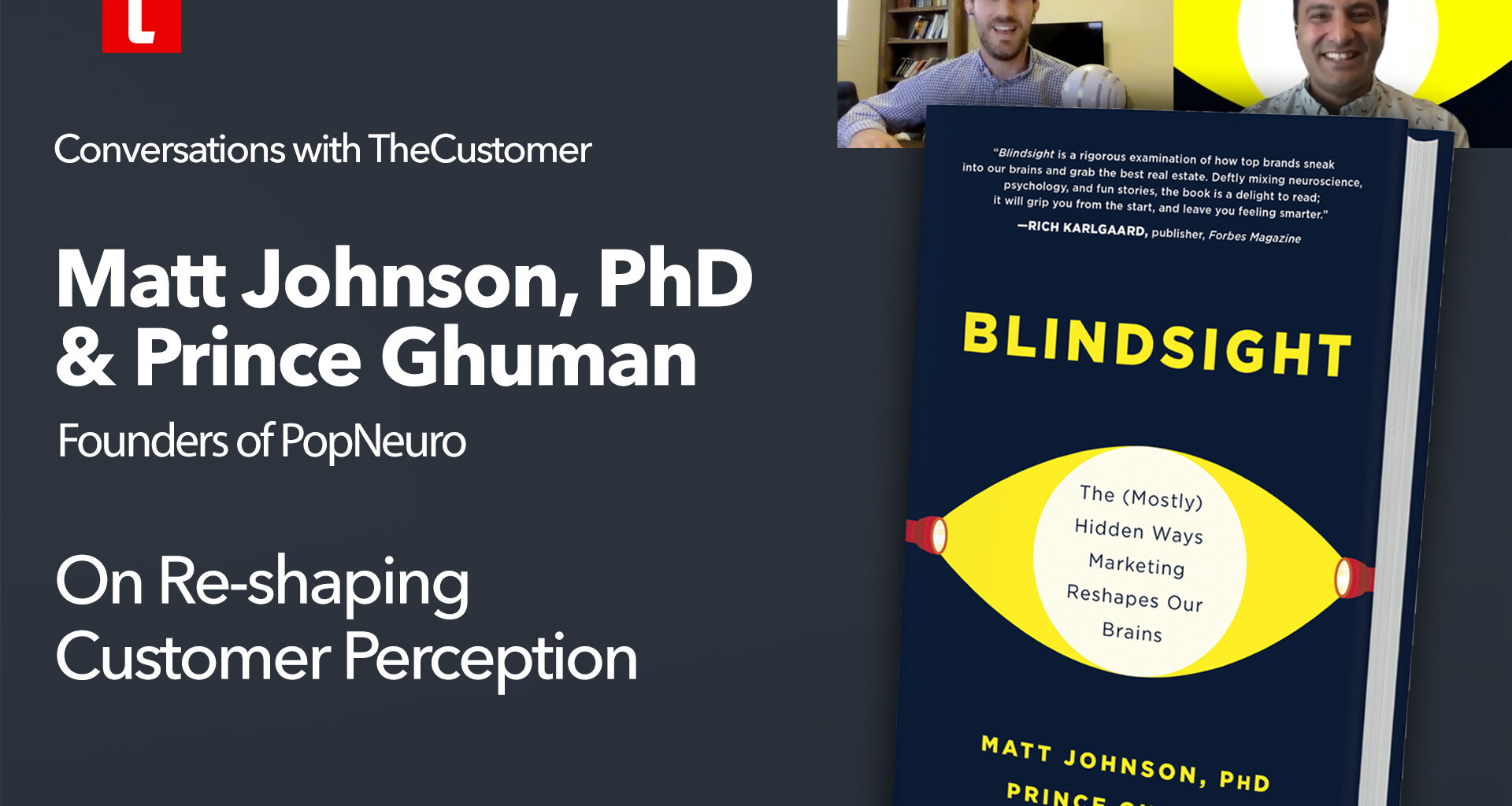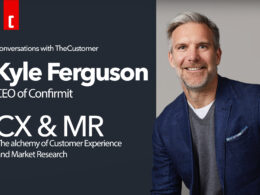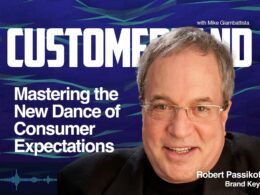Amos Tversky and Daniel Kahneman. Arguably the biggest names and some of the biggest thinkers when it comes to understanding why and how humans actually … think. Their book, “Thinking Fast and Slow” has become one of the foundational texts on how our minds process the infinite number and type of inputs we’re subjected to. That’s where this whole thing began for me. Call it a rabbit hole if you will, but it’s been an enlightening one. Which is why I was so intrigued when I first came across the new book on neuromarketing by Matt Johnson, PhD. and Prince Ghuman, entitled “Blindsight – The (Mostly) Hidden Ways Marketing Shapes Our Brains“.
Johnson and Ghuman are founders of “PopNeuro – a Neuromarketing Blog for the masses”. You gotta love a website that opens with “A Neuroscientist and a Marketer Walk Into A Bar…”
In our wide ranging conversation, Matt & Prince offered up some smart context for why the idea of neuromarketing is becoming a hotter topic in marketing circles. But although they are both teachers, it turns out they’re storytellers at heart. Lots of anecdotes, examples and sidebars later, we had spent way more than our allotted time talking about all the applications for their insights.
For your convenience, we’ve posted a full transcript below. Enjoy.
TRANSCRIPT
MG
I’m Mike Giambattista and I’m the publisher of TheCustomer. And today I have the unique pleasure of conversing with two authors of a book I’ve become fascinated by. Prince Ghuman, sitting in front of his shameless plug. The book is called Blindsight. Right. And it’s brilliant. It’s fascinating. I don’t want to overstate it.
But I’m in danger of it because I’m really enjoying it. Prince and his coauthor, Matt Johnson, who studies this stuff for a living. So, Prince and Matt, I’ve done a terrible job of introducing you. Maybe you wouldn’t mind introducing yourselves a little bit deeper and better.
MJ
Yeah. Well, thank you so much for having us, Mike. I’m Matt Johnson, I come from the academic neuroscience community suburbs and did my PhD in cognitive neuroscience. And for me I’ve always been just driven by curiosity. And I’ve always been curious about why we do the things we do. The brain, I think is the most interesting organ, the most interesting physical thing we could possibly study because it is the nexus by which everything we could possibly experience takes place.
And I’ve always been curious about what makes us tick. And so the best outlet for me was, was doing a PhD and basically spent my mid-twenties in labs and libraries, just getting as, uh, deep into this as possible. Got very, very, very myopic, got very, very specialized, studied some, some nuances of human memory and learning.
And then I graduated and I switched gears slightly in terms of studying the brain in terms of how it generally takes an information and sort of how it interacts with the consumer world. So for me, my impetus for this field is really by curiosity. And I remember when I graduated my PhD, you get an actual hard cover edition of your senior thesis, which is about 120, 130 pages of very, very dense material.
And at this juncture, I’d poured, you know, hours and hours and hours into it. I knew at that point that nobody, you know, outside of my immediate family, right. Would, would read this thing. So when I did the ceremonious thing of putting it into this special place for the library, I took a $20 bill and I put it in my physical thesis and I guarantee you, it is still there today. Probably dropped a little bit in value for inflation, but the $20 is still there. If anyone cares to. To look it up. And for me, that was just the perfect sort of distillation of my orientation. It’s really not for, you know, specific application it’s really driven to, to build on the cumulative wisdom of the field, which really contrasts, you know, pretty paradoxically with, with Prince’s approach.
MG
Well, you know, just a quick note and I want to hear a princess story here, but you know, we don’t often drop Easter eggs in the middle of our, of our pieces here, but there you have one, if you can find the 20 bucks. Yeah, I go, go to the Princeton library, go grab it.
PG
Matt and I have been studying behavior. I call the consumer behavior. He called the human behavior through two completely different lenses. Uh, so while Matt put it eloquently lives in libraries is where he spent a long time. And I was on the other side of it. I was fortunate enough to be in marketing early on in my career.
And what I did was I, I read some abstracts. I braved the abstract world. And as a practitioner, you just want, give me the nuggets that work, right. Well, you gotta earn those nuggets. And, I read as many abstracts as I could on a weekly basis. I read as many well-researched pop psych pop neuro books, as much as I could and was fortunate enough to read a book on a weekend and on Monday, come up with some tests to test out from user experience, to messaging, and what have you.
And then by Friday, have some idea. Some indication of success or failure and you continue those tests. So I did that for a while and I was able to add neuroscience without the PhD, obviously, but completely tactic oriented, complete application oriented. And, that’s not to say I don’t value a map, in fact, tremendously value what academics do. I just think it’s hiding behind scientific journals and. In libraries with $20 bills in them. Right. And I think, and I think when Matt and Matt got together, it was sort of like, you know, the, the proverbial, you know, peanut butter and jelly bromance immediately because we, you know, I had been putting stuff into tactic that he understood deeply, deeply and vice versa.
And I think maybe Matt you’ll agree with this, but subconsciously it was probably a searching. What about put all this knowledge?
MG
Yeah, and I feel your pain too. You know, I, uh, I come from the practical side of this and, um, if you’re looking for real genuine, You know, the nuggets, not just the tips, but to how to, you know, give me some genuine insight. It’s really, really hard to find credible sources out there. And I think, and again with the shameless plug, but I think that’s one of the reasons I’m so glad that whatever serendipitous SEO thing happened to bring your site into our feeds. I’m glad it did because we’ve had a lot of interesting conversations just from the stuff that you guys have published here.
And like I said before, we started here, I’m literally like 20% of the way through your book.
PG
I’m so excited for you to read the rest of it. It’s, uh, you know, like Matt and I will nerd out on hip hop sampling or Korean pop music, and then take a neuro marketing approach on why it’s popular and then we’ll just run a blog about it. And I think, I think we’re so fortunate that we have that, that chemistry to actually do that.
I think there is a distrust, almost, between consumers and marketers, even though marketers want to create amazing products for consumers to consume and consumers want to fall in love with them. And I think that, I think that’s part of the reason why we wrote Blindsight. We want consumers to appreciate all the work that goes into it, but we also want marketers to be aware that, you know some of the stuff is a way to charm and actually earn a sale.
And it was the drive that, that pushed Matt and I forward into sort of revealing as much as we could, um, with research back, like you said, um, but also making it digestible and not feel like a a textbook.
MG
Well, what reads really fast. It wants me to keep going faster than I want to keep going, which is, which is the fun thing, because I’m really just digging it a lot. I think from my background and for a lot of our readers, we’re, we’re marketers. We’re, that’s, that’s our perspective on life. And, you know, over the years, because I’ve been at this quite awhile, I mean, The gray hair proves a couple of things, but you know, there are manipulative tactics and then there and disingenuous tactics, um, that probably have more to do with, you know, why you’re deploying them in the first place, but able to understand, to have a real healthy, robust set of tools in your tool belt.
I don’t think it could hurt any marketer and what you do with them. Again, that’s probably a matter of ethics and morals. We can talk about that more. At some other point, but, but I have a real, and I think that the readers share this a real passion for trying to figure out in this increasingly complex customer relationships – how to manage them better and trust. As you said, Prince, it’s one of the core components of any customer relationship. And in fact, we’ve run surveys just recently and they’re corroborated by basically everybody that consumer trust is at a historic low, um, you know, it may have something to do with our political climate, but even if you remove that, it probably has a lot to do with the way marketers have just approached consumers. Like I want to make that transaction. I want to maximize the value out of this, and then I want to walk home, you know, get out of here. And so one of the reasons, I guess I’m more passionate about what you guys are doing is that it exposes tactics that we’re all susceptible to. And as marketers, we can all deploy. If we understand them,
PG
Yeah. And I agree. I think I think one of the things is a great example. I’ll use memory as an example. Every marketer should know the foundations of the neuroscience of memory, because there are ways to actually use that to better connect with the consumer, right.
Not get them hooked, none of that stuff. It’s can you genuinely be more memorable to your consumer? Because as consumers we want. That we want memorable brand experiences. I think Matt, it would be great if you, if you sort of, uh, gave everyone an overview of the neuroscience of memory and we’ll try to connect it.
MJ
I mean, Prince Prince is absolutely right. That what we ultimately want is alignment that in addition to the, the product aspect of it, that consumers want products, they also want amazing experiences. They want to think of brands in particular ways. And so, in order for brands to do that, they really have to optimize for memory and memory.
When we sort of reflect on this – just ourselves – it’s one of those things about the human condition we just get so wrong. It’s such an amazing thing that it’s so central to our lives. And yet it’s something that our intuition is so off about. So, we think of memory as you know, when we’re going through life, we have the record button.
And then when we are recalling an experience, we just have the replay button on and it’s just a faithful replay of that experience, or as much as it is as you record it. Um, but it turns out that neither of those things are true. That really when it comes to. Experience, uh, there there’s things about the experience that are weighed more heavily in memory.
And so, something we dive into a lot in the book, these specific things about an experience, which can, by the way, be designed for, by marketers. So things like music, uh, there there’s these fascinating case studies of people who are riddled with, sadly, dementia and, and they are at the point where they don’t know their names. They don’t know the names of their loved ones, but if somebody in that hospital room starts singing a song from that person’s youth, they will just automatically have a smile on for their head and they’ll start singing it as well.
Cause music just has such a such a hold. on us. And it’s so widely distributed in terms of how this is laid down in the brains. Everyone thinks, you know, music and consumer is always just talking about jingles, but there’s so much more you can do than that. So that’s one sort of bet that Prince and I have placed that, that we’re going to see a revival of, of Sonic branding because the visual space is, is.
Obviously well-known, vision is, is such an important part of, of who we are as humans. A third of the cortex is dedicated to it, but that is saturated. Everyone has a logo. Everyone has a branded color, this and that it’s much different when it comes to sound. It’s, it’s pretty wide open. So that’s one area where it’s underutilized. I think in terms of how, uh, these things can be used to design for impressions.
PG
We talked about things like friction, adding a little bit of friction into consumer experience that is sort of this, this big no-no when it comes to a UX, you want, you know, really, really, really frictionless experience. You want to get people to the checkout, et cetera. And that’s true for many instances, but if you’re trying to lay down an impression, if you’re trying to build a memory, but inserting just a little bit of friction in the right way can actually boost that memory. So, we talked in the book about this, this specialized font called Sans Forgettica.
And this font, which is engineered to be just a little bit difficult to read – you can definitely read it if you, you know, spend a bit of time, but you can’t just like, you know, see it in passing and, and pay minimal attention to it. In the words don’t just come to mind readily.
And studies have shown that if you print information and sun’s forgetting a font versus like a times Roman, then you actually remember it much more because it forces you to strain your attention. So little things that creative experiences that others can do to, to design an experience in a way, not just for the moment to moment experience, but for the impressions that it leaves. And I think neuroscience really has a strong role to play there.
MG
So, one of the first real concepts in your book is anchoring. And I’d love to hear you guys explain this from your standpoint, but as I understand it, um, and I grew up in the wine business, which makes me a little bit of a whiner, but it’s, but it’s my DNA, so I can’t help it but you, you abuse wine lovers. Handily
And I’ve since questioned everything I thought I knew about the appreciation of wine. So, you know, you’ve ruined. Um, but having said that maybe we can talk a little bit about, about the definitions and its utility in terms of marketing.
MJ
Yeah. So, so for firstly, you know, diving into this topic of anchoring, so we don’t experience absolutes, it’s sort of a very general way of going about and experiencing the world. We have a hard time with absolutes. You know, if you get a test back on our score, back on an exam you took and you got a 178. Is that good? Is that bad? Is that an F? Is that an eight grade? You have no idea. So, you have to look for benchmarks so you can look for your percentile in the class 178, maybe that’s a 85th percentile and you feel, yeah, maybe pretty good. It’s sort of a marker.
We look for these benchmarks to give a numbers, meaning, and this is exactly what marketers do when it comes to pricing. So the same $20. So, if anything’s fungible in life, it’s money, right? $20 is $20 in terms of its economic value as a purchasing power, but $20, doesn’t always feel like $20 psychologically.
So if, for example, you are checking out for a pair of jeans and the two pair of jeans cost $60. That’s your, your reference? That’s your anchoring point. And then at the end of the transaction is, Oh, sorry. I forgot about this one tax. It’s not actually on sale. It’s going to be $80. That 20 extra dollars feels like it feels pretty painful cause you’re anchoring it to $60.
But imagine that same $20 and it’s tacked on to a purchase of an F150. So, it’s a $30,000 expense. They said, Oh, sorry. You know, it’s a one little, you know, it’s a service fee or something like that. You don’t even notice these things, right. It’s $30,000 purchase. What’s another 20 bucks. But of course, 20 bucks is 20 bucks, 20 bucks.
Whether it’s tacked onto a $30,000 purchase or a $60 purchase, but does it feel that way psychologically? So that’s one way in which anchors really has a huge impact on us as consumers, especially in the realm of pricing.
MG
So over the past few days, um, it’s hit me, uh, over several purchases that I’ve made and how I have, um, been fully abused by marketers in the process. Now that I’m watching people around me, they will often pick the glass of wine or the, or the level of quality of gas at the station or whatever it is based on. There are anchored highs and lows. It’s fascinating stuff.
PG
Right? Right. So just saying that (the wine) is Italian versus from Delaware, no offense to anyone from Delaware, but Italian wine is the anchor, as opposed to the Delaware ankle. And if you know nothing else, you’re going to associate that. Right. Um, and when you don’t have the region in there and you only have price that that’s why there’s all these repeated verified.
Studies that show that higher price wines taste better even if it’s exact same bottle, exact same and same thing with glasses, you know, red paper cup is a data point, um, is an anchor, right? So, pricing is definitely one thing. And I think pricing, you know, people, uh, you know, behavior economics expose our biases towards anchorman prices awhile back, and that’s great.
Um, but there’s other ways to anchor and, and we sort of do it a lot and it does, it says a lot about our sense of perception, our sense of value, and ultimately does lead into attention. Um, yeah, there’s a lot going on. Yeah, there’s a lot going on.
MG
I think I should say for the record, I could keep talking about this stuff for hours, literally. I mean, you know, and you to actually know what you’re talking about, which is refreshing. It’s not just me in a vacuum. And I would, I would very much like to do that, but I think for now, this has been a great little conversation and I’m looking forward to many more of them. So Prince Ghuman, Matt Johnson.
Thank you both for the book, for the blog. And let’s do a little more shameless plugging. Um, the blog is called Popneuro.com. It’s filled with fascinating anecdotes and stories. The book I’m just getting into it’s called Blindsight. You can find it on Amazon. Um, I don’t make any commission. I’m just recommending it because it’s a great book and, um, Thanks again for joining me, looking forward to more of these that’s great.
Thanks so much for having us.













6 comments